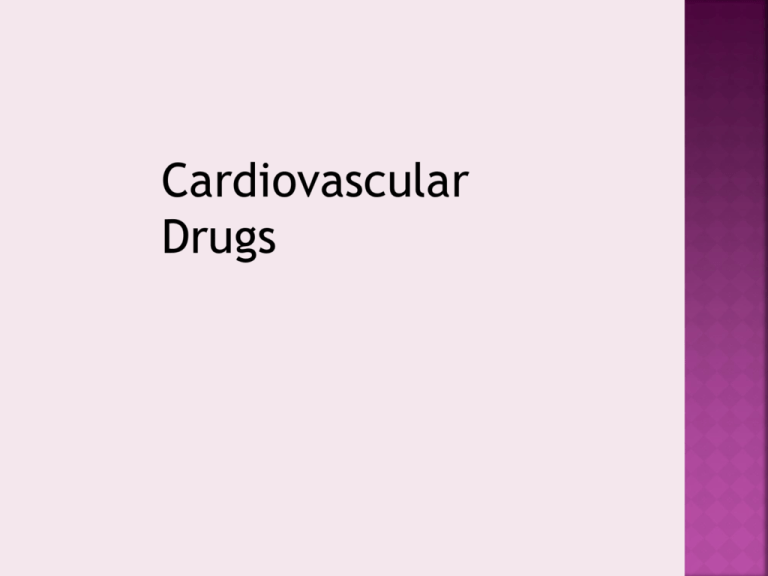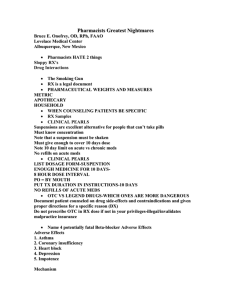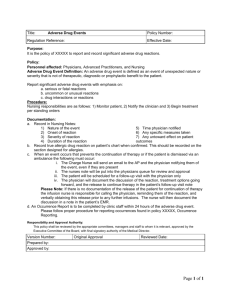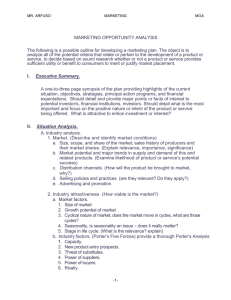Cardiac Meds Powerpoint - Phlebotomy Career Training
advertisement

Cardiovascular Drugs Cardiac Glycosides Digitalis is derived from the foxglove plant and has been used for over 400 years to treat symptoms of heart failure. Lanoxin (digoxin) – most often used form. Can be given PO or IV. MOA: Positive inotrophic action – increases strength of myocardial contraction causing increase in COP and decrease in O2 demand. Lanoxin MOA: 1. Positive inotrophic action – increases strength of myocardial contraction causing increase in COP and decrease in O2 demand. 2. Negative chronotropic action – decreases HR by decreasing impulse formation in the SA node. It indirectly stimulates the vagus nerve. Together these actions lead to a decrease in compensatory tachycardia (sympathetic nervous system). 3. Negative dronotrophic action – slowed conduction of impulses through the AV node Lanoxin Uses: CHF to treat sx of decreased COP, A-fib, A flutter. Adverse Effects: Anorexia, N,V,D, fatigue, dizziness, visual disturbances (yellow vision, blurred vision, seeing halos around lights, double vision.) These are helpful in dx of toxic levels. Dose reductions may be necessary due to decreased renal function in the elderly. Digoxin Digoxin has a narrow therapeutic range (0.52.0ng/ml). Levels are drawn just prior to a dose. Doses should be given at the same time each day. Nursing Measures: Take apical pulse for a full minute prior to each dose. Hold drug and notify HCP if pulse < 60. Be aware of factors that predispose to toxicity – hypokalemia, hypercalcemia, hypoxia related to heart of lung disease, and renal or liver disease. Digoxin Nursing measures continued Quinaglute and other antiarrythmic drugs, calcium salts and calcium channel blockers, adrenergic drugs, and anticholinergics when given with digoxin cause increased digoxin levels. Digoxin may have to be decreased by 50% when given with quinidine or amidrome and 25% for calcium channel blockers. Antiacids, Questran (cholestyramine), laxatives, and neomycin decrease effects of oral digoxin. Antidote: DigibindDigoxin Nursing measures continued Instruct patient regarding: Take pulse before each dose, take same time each day, do not double dose if misses a dose, report adverse effects, report weight gain of more than 1# per day or more than 3# per week. Antiarrythmic Drugs This class of drugs alter the conduction of electrical impulses in the heart and are primarily used for tachydisrhythmias. Research has shown that patients treated for some dysrhythmias had a higher death rate than those who did not receive the therapy. These deaths were attributed to the effects of the drugs worsening existing dysrhythmias or causing new dysrhythmias. These studies have lead to a decrease in use some of these class I drugs (quinidine) and higher use of class II drug (beta blockers) and class III drugs (amiodrone). Antiarrythmic Drugs There is now greater use of radiofrequency catheter ablation, surgically implanted cardioverter defibrillators (ICDs) Uses: Convert A-fib or flutter to NSR. Maintain NSR after conversion from a-fib or flutter. When ventricular rate is so fast that decreased COP leads to sx of decreased systemic, cerebral and coronary circulation. To terminate dangerous dysrhythmias that may be fatal such as ventricular tachycardia Class I Antidysrhythmias Examples: Class 1a Quinaglute (quinidine) prototype for class 1a Norpace (disopyramide) Pronestyl (procainamide) Uses: symptomatic PVCS, SVT, V tach, prevent vfib. Class 1b Xylocaine (lidocaine) prototype for class 1b Uses: symptomatic PVCs, V tach, prevent v-fib. Quinaglute (quinidine) Adverse Effects: N,V,D, hearing loss, tinnitus, visual disturbances. Nursing Measures: Inform all HCPs that patient is taking the drug. Report adverse effects and feeling faint (Vtach or fib). Best to take on empty stomach with glass of water, but may take with food if GI sx. Avoid excessive citrus juices because they change urine pH and decrease excretion of quinidine Pronestyl (procainamide) Similar to quinidine Adverse effects: Anorexia, N, hypotension (IV), SLE like syndrome, V fib. Contraindications: Allergy to procaine, 2nd or 3rd degree heart block, liver or renal disease. Nursing Measures: Give with food, avoid hazardous activities until effects are known, avoid OTC drugs. Norpace (disopyramide) Similar to quinidine Adverse Effects: Dizziness, fatigue, HA, blurred vision, dry mouth, CHF, arrhythmias, hypotension, constipation, N, urinary retention, hypoglycemia. Contraindications: Cardiogenic shock, 2nd and 3rd degree blocks, sick sinus syndrome w/o pacemaker. Interactions: Many - cimetidine, warfarin, erythromycin, dilantin, etc. Xylocaine (lidocaine) Local anesthetic, drug of choice for treating serious ventricular arrhythmias. Decreases myocardial irritability in the ventricles, but has little or no effect on the artria. Differs from quinidine in that: Always given IV, no decrease in AV conduction or cardiac contractility in therapeutic doses, rapid onset, 1to2 minutes, and short duration, 20 min, of action, it is less likely to cause heart blocks, asystole, heart failure or V arrhythmias. Lidocaine Adverse Effects: Drowsiness, tinnitus, blurred or double vision, anaphylaxis, seizures. Contraindications: Allergy to local anesthetics, heart blocks. Nursing Measures: Ensure correct preparation and dose prior to administration. Monitor EKG. Anticoagulants Anticoagulants prevent formation of new clots and the extension of existing clots. They do not dissolve clots, improve blood flow to tissues, or prevent damage from ischemia to tissues beyond the clot. Uses: Prevention or management of thrombophlebitis, DVT, or pulmonary embolism. Adverse Effects: Bleeding Heparin Uses: Prevention and management of thromboembolic disorders, DVT, PE, and Afib with embolization. MOA: Prevents the ultimate formation of fibrin in stage III of the clotting mechanism. Antagonizes thrombin and prevents conversion of fibrinogen to fibrin. Adverse Effects: Bleeding – hematuria, nose bleeds, rash, alopecia, thrombocytopenia (decreased platelets, can be very severe). Heparin Contraindications: Bleeding disorders, recent surgery, renal or liver disease. Pregnancy cat. C. Does not cross placenta. Given subcutaneously or IV. PTT (partial thromboplastin time) and INR (international normalized ratio) are labs used to evaluate therapeutic effect. Dose is adjusted based on these tests. Antagonist/Antidote: Protamine sulfate Heparin Nursing Measures: Teach to wear or carry ID and notify all HCPs that he is taking drug. Smoking and alcohol may alter response to drug. Avoid ASA, NSAIDS, & OTC drugs w/o consulting HCP. May increase menstrual flow. Alopecia is reversible. Should be able to carry out normal activities such as shaving because it does not affect bleeding time when platelets are normal. Coumadin (warfarin) Uses: DVT, PE, A-fib, prosthetic valves prophylaxis. MOA: Indirectly interferes with the hepatic synthesis of Vitamin K-dependent coagulation factors (II, VII, IX, X). Adverse Effects: Bleeding, purple toe syndrome (microemboli to toes). Contraindications: Pregnancy Cat. D (never use in first trimester), liver disease. Coumadin Nursing Measures: PT (prothrombin time) and INR are labs used to determine therapeutic effects. Avoid IM injections while on Coumadin. Teach patient regarding: Purpose, dose and S/S of adverse effects. Avoid all alcohol and excessive intake of foods high in Vit. K. Carry ID & notify all HCPs he is taking drug. Antidote: Vitamin K Lovenox (enoxaparin) Low molecular weigh heparin. Uses: Prevention and management of DVT and PE. Management of unstable angina, to prevent MI. Adverse Effects: Less thrombocytopenia than standard heparin. Can be used for outpatient therapy because they do not require close monitoring of labs. Platelet counts should be monitored. Antidote: Protamine sulfate Antiplatelet Drugs Aspirin Antiplatelet effect lasts for the life of the platelet, 7-10 days. Uses: Long term for prevention of MI or CVA and for patients with prosthetic heart valves. Immediate treatment for MI, TIA, or thrombotic CVA. Adverse Effects: Low with therapeutic doses. Bleeding and hemorrhagic strokes. Nursing Measures: Teach to report GI irritation or signs of bleeding. Thrombolytic Drugs Uses: To dissolve thrombi in MI, CVA, and ileofemoral thrombosis and to dissolve clots in IV catheters. MOA: Stimulate the conversion of plasminogen to plasmin, a protelytic enzyme that breaks down fibrin which is the framework of a clot. Examples: Urokinase and streptokinase. Urokinase can be used for patients who are allergic to streptokinase. Adverse Effects: Bleeding Antianginal Drugs Relieve angina pain by reduction in myocardial O2 demand and increasing blood supply to the myocardium. Nitrates, beta blockers and calcium channel blockers are used. Nitrates: Nitroglycerine (prototype), Nitro-bid, Isordil MOA: Reduce PVD (afterload) results in decreased systolic BP which reduces workload of the heart. Reduce venous pressure and venous return to the heart which decreases volume and pressure in the heart (preload) which reduces O2 demand. At higher doses they dilate coronary arteries and increase blood flow to the heart muscle. Nitrates Routes: Has a short half-life of 1-5 min. regardless of route. Sustained release oral or transdermal patch is used for prevention. PO – act slowly, used for prevention. Sublingual – acts within 1-3 min. and last for 30-60 min. Used for acute attacks and to prevent exercise induced angina. Transdermal - effective for 12 hours. IV is used when other agents are not effective. Nitroglycerine Patches must be removed for 10-12 hours each night to prevent nitrate tolerance. Adverse Effects: HA, dizziness, hypotension, and tachycardia. Contraindications: Current use of Viagra, severe anemia. Interactions: Viagra, antihypertensives, alcohol, haldol, anticholinergics. Nursing Measures: Teaching re: storage, safety, use of different preparations. Beta Blockers Examples: Inderal, Tenormin, Lopressor, Corgard MOA: Decrease sympathetic stimulation to decrease HR and myocardial contractility, especially during increased exercise decreasing need for SL nitroglycerine. Also reduce BP which decreases workload of heart and O2 demand. Uses: Angina, hypertension, etc. Contraindications: Vasospastic Angina because they may increase frequency and severity of vasospasms. Calcium Channel Blockers Examples: Cardizem (diltiazem), Calan (verapamil) MOA: Improve blood supply to heart muscle by dilating coronary vessels and decrease the workload of the heart by dilating peripheral vessels which lowers BP. They reduce coronary artery spasm. Verapamil and Calan are the only CCBs that slow the ventricular response to A-fib, flutter and SVT. Calcium Channel Blockers Uses: Angina, hypertension, etc. Contraindications: 2nd or 3rd degree blocks, cardiogenic shock, severe bradycardia, heart failure, hypotension. CCB can be monotherapy, but are frequently used in combination with beta blockers. Antihyprelipidemics Agents to decrease blood lipid levels. They are adjunct in antianginal therapy. Bile Acid Sequestering Agents Example: Questran (cholestyramine) MOA: Decreases LDL levels by absorbing and combining with bile acid salts in the intestines to form an insoluble, nonabsorbable complex that is excreted in the feces. Uses: Decrease LDL Questran Adverse Effects: GI sx which usually subside by a month, increased bleeding tendency. Decreases absorption of many drugs. Long term use may result in deficiencies of fat soluble vitamins – A,D,E,K and Ca. Nursing Measures: Give other meds 1 hour before or at least 2 hours after. Dissolve in flavored liquids or semisolid foods to disguise taste. Teach S/S bleeding, need for Ca and vitamin supplements with long term use. Fibric Acid Deriviatives Lopid (gemfibrozil) MOA: Unclear, but decreases Triglycerides and VLDL, increases HDL, cholesterol may increase or decrease. Uses: Decrease triglycerides, decrease LDL is secondary effect. Adverse Effects: Myalgias, impaired liver function, gall stones, abd. pain, N, D. Less hyperglycemic effect, best for diabetics. Teach: Restrict alcohol, fats, chol, and sugar. HMG-CoA Reductase Inhibitors (statins) Examples: Zocor, Mevacor, Lipitor, Pravachol MOA: Inhibit HMG-CoA reductase, an enzyme essential in synthesis of cholesterol. Lower LDL and VLDL and triglycerides, and increase HDL. Many health benefits unrelated to lipids. Uses: Decrease LDL in hypercholesterolemia/hypertriglyceridemi a Adverse Effects: Myalgias, liver damage, HA, rash, GI sx. Nursing Measures: Monitor labs, give in evening, teach compliance with diet and sx to report. Antihypertensives Review: Pathophysiology of hypertension Antihypertensives work in three basic ways to decrease BP. 1. Decrease fluid volume, diuresis. 2. Decrease HR 3. Decrease PVR There are different classes that work in different ways. They may be used alone or in combinations. Central Sympatholytic (Central Acting Adrenergic Inhibitors) Example: Catapress (clonidine) MOA: Stimulates alpha receptors in brain to inhibit peripheral sympathetic activity resulting in vasodilatation (decreased PVR) and decreased BP. Reduces HR. Uses: Hypertension. Off-label: Migraine prophylaxis, drug withdrawal sx. Adverse Effects: depression Avoid alcohol & CNS depressants, gradual withdrawal to prevent rebound hypertension. Alpha Adrenergic Blockers Example: Hytrin (terazosin) Minipress (prazosin) MOA: Decreases PVR and lowers BP by selectively blocking the alpha 1 adrenergic receptors in vascular smooth muscle. Uses: Hypertension. Off-label: Urinary flow obstruction in BPH. Adverse Effects: Severe orthostasis, especially first dose – give at bedtime. Nursing Measures: Standing BP Beta Adrenergic Blockers Examples: Tenormin (atenolol), Inderal (propanolol), Lopressor (metoprolol) MOA: Non-selective blockers of beta 1 and beta 2 receptors by competing with epinephrine and NE for available beta receptor sites. Lower COP and BP by decreasing HR, force of contraction and renin release from the kidneys. Uses: Hypertension, angina, prevent 2nd MI, tachyarrythmias. Off-label: Migraine prophylaxis, antianxiety, acute panic sx. Beta Blockers Contraindications: CHF, COPD, Asthma (may cause bronchospasms), heart block > 1st degree. Caution: Diabetes (blocks sx of hypoglycemia). Nursing Measures: Teach that abrupt withdrawal may lead to angina, MI or death. ACE Inhibitors Examples: Quinipril (accupril), Capoten (captopril), Vasotec (enalapril), Lotensin (benaepril) MOA: Block the conversion of angiotensin I to angiotensin II, a potent vasoconstrictor by specific inhibition of the angiotensin converting enzyme. This results in decreased PVR. Uses: Hypertension, Used after MI if ejection fraction < 40, protects diabetics from renal failure. ACE Inhibitors Adverse Effects: Dry cough, angioneurotic edema, hyperkalemia, ARF. Contraindications: Pregnancy – renal failure in infants, renal impairment. Nursing Measures: Instruct regarding need for return to have K drawn. Vasodilators Examples: Apresoline (hydralazine), Nipride (nitroprusside), Nitroglycerine. MOA: Vasodilators cause a direct relaxation of vascular smooth muscle to decrease PVR and lower BP. There are two types: atreriolar dilators and venous dilators. Uses: Hypertension, angina They are usually given with a beta blocker to prevent hypotension-induced compensatory mechanisms of tachycardia and fluid retention that raise BP. Calcium Channel Blockers Examples: Cardizem (diltiazam), Calan (verapamil), Procardia (nifedipine) MOA: Selectively block Ca ions from crossing cell membranes in cardiac and vascular smooth muscles without affecting serum Ca levels. They relax and prevent coronary artery spasm and reduce myocardial O2 use and may reduce HR by slowing conduction through SA & AV nodes. Cause vasodilatation of coronary and peripheral vessels. Ca Channel Blockers Uses: Hypertension, Angina (verapamil and diltiazem), SVT, cerebrospasm in SAH (nimodipine). Off-label: Migraine prophylaxis Most effective in blacks and elderly. Agents for Anemia Iron deficiency anemia is a symptom, not a disease. The cause should always be investigated, especially in men. 80% of iron in the plasma goes to the bone marrow for use in erythropoesis – manufacture of RBC. When iron stores are low, iron absorption increases by 20-30%. When iron stores are high the rate of absorption is 5-10%. Ferrous Sulfate It is the gold standard. Cheapest, just are effective as any. MOA: Corrects erythropoetic abnormalities caused by iron deficiency. Does not stimulate erythropoesis. Uses: Iron deficiency anemia Ferrous Sulfate Adverse Effects: Generally mild in therapeutic doses. N, heartburn, constipation or diarrhea. Contraindications: PUD Better absorption on empty stomach – give with food for GI sx. Stains teeth. Milk, eggs and caffeine decrease absorption. Vit.C increases absorption. Imferon (iron dextran) Given IV or IM by Z tract. Uses: Severe iron deficiency anemia Adverse Effects: Anaphylaxis, stains tissues Builds iron stores faster, but does not correct anemia any faster than oral iron. Nursing Measures: Skin test prior to IV dose. Test dose prior to IM. Give in dorsogluteal. Change needle after drawing up med., use air lock. Monitor for adverse effects for 24 hr. Vitamin B 12 (cyanocobalamin) MOA: Activates folic acid enzymes that are necessary for synthesis of RBC. Uses: Pernicious anemia (IM). Arrests disease, does not reverse it. Nutritional supplement: Must have intrinsic factor to absorb PO. Adverse Effects: Transient itching and pain at site, optic nerve atrophy, CHF. Overview of Four ACLS Algorithm Protocols Objectives To review routes of administration for medications used in code blue emergencies To introduce several common ECG rhythms To familiarize the pharmacists with four ACLS algorithms To identify the most common drugs used by the ACLS algorithms IV Push Route of most medications used Convenient Fast onset of action Immediate bioavailability Intravenous Infusion Medications for continuous infusion only P – procainamide I – isoproterenol N – norepinephrine D – dopamine Medications given IV push or infusion A – amiodarone L – lidocaine E – epinephrine Endotracheal Administration Tracheal administration of medications L – lidocaine (2-4 mg/kg) E – epinephrine (2-2.5 mg) A – atropine (2-3 mg) N – naloxone (0.8-1.6 mg) Doses usually 2-2.5 times those given IVP Follow each dose with 10 ml NS flush down tracheal tube if not diluted to that volume for administration •Use of Algorithms • Meant to treat broadest range possible of •patients • Meant to be good memory aids • Meant to be used “wisely,” not blindly • Not meant to replace clinical judgment






